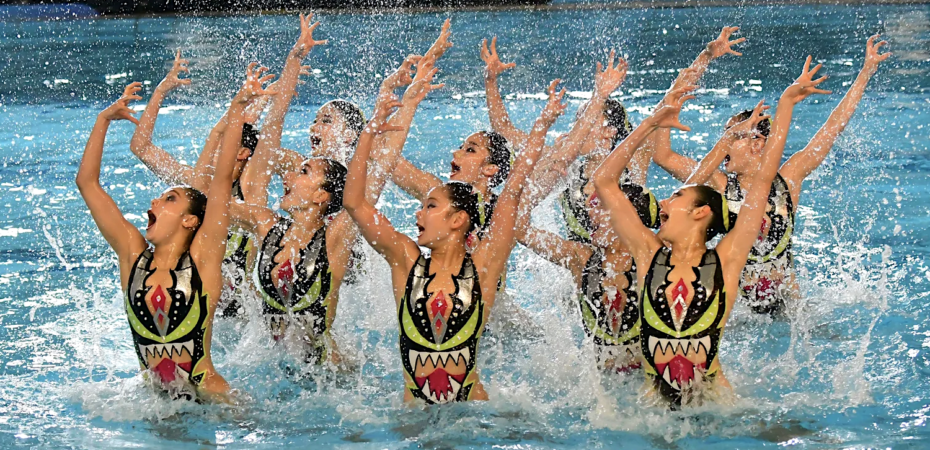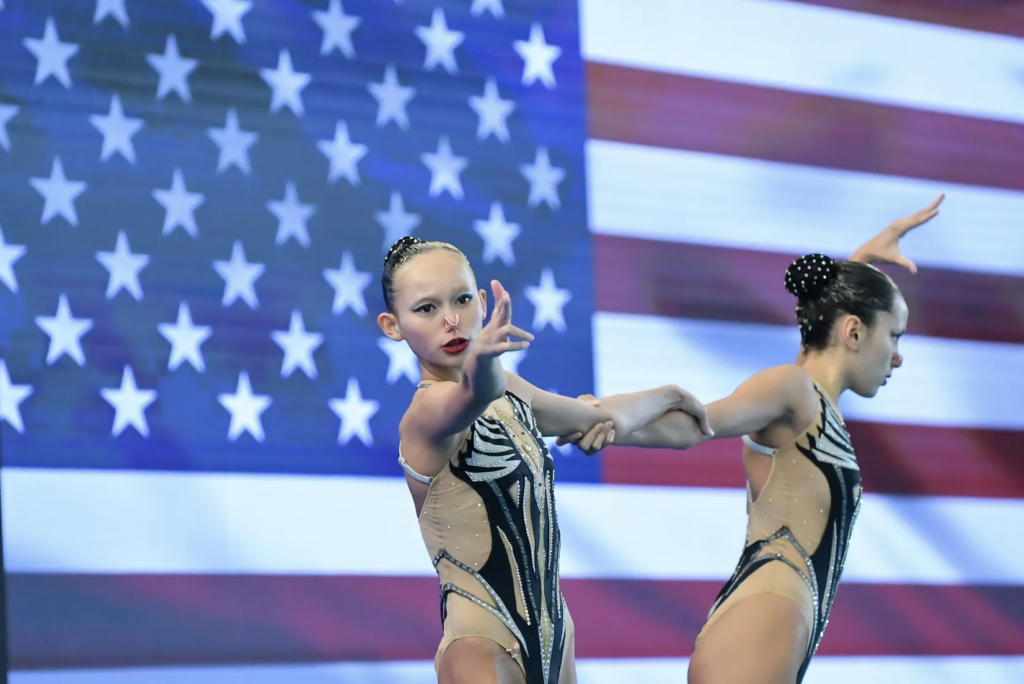270 athletes gathered in Athens, Greece, last week to compete in the third World Youth Championships across seven artistic swimming events.
Amongst the 34 nations in attendance, the small island of Cyprus made its historical debut in artistic swimming, competing in the duet event. Additionally, Poland and Croatia were entered in the mixed duet event, a first for these countries across all age groups.
This meet was also the first one under the new rules for this category, including the new figures regulation. Indeed, youth athletes now only compete two figures instead of four. However, athletes on the same team may not do the same figures, as the swimmers are randomly assigned to two groups, each with two different figures. The figures in each group have matching Degrees of Difficulty (DD).
In Athens, swimmers were split between Group 1, which consisted of Whip Continuous Spin 720° and Saturn, and Group 2 with Venus and Albatross Spin up 360°. Of the top 25, every athlete but three did the figures from Group 1. The figures score is then added to the routine score to determine the finalists and rankings for the solo, duet, mixed duet, and team events.
Japan was amongst the most successful nations in this competition, topping the medal table with two golds and four medals total. Just like in the senior category, the nation has successfully navigated the rules changes here as well and defended its World title from 2022 in the free combination event with a score of 242.4022.
The Japanese also won gold in team with a 299.2097 for their “Clocks” routine, and added a silver in duet and bronze in solo to their medal haul. Shirahase Nao, who already competed in last year’s World Youth Championships, will be one to watch after being part of all four medal efforts.
The future is also bright for the USA, as demonstrated by this youth squad that earned six medals. Kanako Field was particularly outstanding in her very first international meet. The 13-year-old became a World Youth Champion in figures before winning silver in solo as well as bronze medals in duet and team. She also notably received the highest artistic impression score of the solo final, with a 84.8500 for her routine set to a violin rendition of “They don’t care about us” by David Garrett.
Kanako, the younger sister of senior national team and duet member Megumi Field, is undoubtedly one of the biggest up-and-coming stars to come out of this competition. With such extensive talent running in the family and only five years separating the two, it wouldn’t be surprising to eventually see a Field sisters’ duet in the future.
In his second World Youth Championships, Michael Chan was also tremendous for the Americans, winning bronze in solo and mixed duet, and helping the “Robots” free combination routine to a fourth-place finish. Chan was actually the sole male athlete to swim in a team routine at this competition.
After tremendous results in the senior and junior categories this season, Spain continued to show consistency and a good understanding of the new system, which helped them win three World medals here. Throughout the year, the Spaniards have overall managed to maintain a sound balance between the DD of the hybrids and the abilities of the athletes, all while really emphasizing artistic impression in all routines. It was also lovely to see the famous 2009 “Stairway to Heaven” free combination routine revived by this young group, which helped them to bronze and a score of 228.4660.
Although she didn’t medal, Paula Marcipar is yet another young Spanish soloist showing tremendous potential, displaying a flowy first lap and a noticeable effort on musicality and choreography as she swam to “Pena Salada” by Silvia Perez Cruz. While her figures score wasn’t enough to keep her in contention for the podium, she did receive the third-best score for her routine.
In the solos, Romane Temessek of France and Filippo Pelati of Italy won their respective events. Temessek, who had won silver in figures the previous day, scored 261.6123 for gold with her “Feeling Good” routine. Although she had finished ninth in the preliminaries, the 14-year-old came back strong in the final and was credited with her full DD of 30.65, the highest of the field. She was helped to the top of the solo rankings thanks to her second-place finish in the figures competition.
On the boys’ side, Pelati dominated and earned gold with a score of 250.5167. He had finished second in the preliminary round behind Chan, but managed a base mark-less swim in the final to win Italy’s sole medal of these championships.
Overall, the 16-year-old has had a tremendous season, winning everything he was eligible for in the solo event: the Italian National Championships in both senior and junior categories, the European Junior Championships and now the World Youth Championships.
The fight for the medals was a close one in the duet, with Greece, Japan and the USA only separated by 1.5 points in the final. In the end, Estella Karamanidou and Vasiliki Thanou of Greece came out victorious in front of the home crowd, edging out Japan for the gold by 0.8239. They received a total of 262.3942, helped to the top of the podium by their figures score of 79.6818, the highest of any pair in the final.
13-year-old twins Xu Kexin and Xu Keyi of China actually had the highest DD of 36.10 as well as the highest routine score (191.6167) for their “Cranes” routine, a former choreography from Olympians Jiang Tingting and Jiang Wenwen. Unfortunately, Kexin had received a zero on one of her figures, which significantly dropped the pair’s figures total and kept them away from the podium this time around. Nonetheless, these two are still very young and ones to keep track of.
China did win the mixed duet event as Ji Heyue and Yang Shuncheng grabbed gold with 243.1085 for their “Wheel of Fortune” routine. Yang actually earned himself a full set of medals in Athens, also winning silver in solo and bronze in figures. The 16-year-old had already competed in the solo event earlier in this season in the Soma Bay World Cup, where he had comfortably won the technical and free solo events amongst the senior field.
Another up-and-coming athlete to keep an eye on is 14-year-old Zeina Amr from Egypt, who scored over 80 points in figures to rank 10th there, and who later finished sixth in solo with a routine set to “Con te partiro” of Andrea Bocelli. Overall, Egypt had a strong showing at these World Youth Championships, seemingly riding the great momentum of the senior squad from the Fukuoka World Championships. In Athens, the nation qualified to the final of every event it entered, and finished fifth in combo, seventh in team and 11th in duet.
This competition also had its fair share of heartbreaks, especially for Poland in the free team preliminary and Australia in the free combination preliminary. The Polish team had started off its routine quite well, but one athlete lost her noseclip in the middle of it. She desperately tried to put it back on, but the team incurred two base marks as well as over 57 points in synchronization errors (SE). The team’s Elements score was actually of -1.9198, which was eventually adjusted to zero in the final scoresheet. Australia suffered the same fate in combo with 58.6 points in synchronization errors on top of four base marks, with one athlete not executing parts of a six-person hybrid. Sure, the rules are the rules, but must it really come down to athletes receiving a zero in such circumstances, as if nothing else they did was worth anything?
Finally, the shortcomings of the new rules may have been the most blatant in this age group. Obviously, the race to the highest DD is still alive and well, even if it means a loss in variety, height, execution, and artistic impression. Right now and without figures, a routine can receive the lowest artistic impression score of a final and still rank first if the full (very high) DD is credited. The hybrids have become one and the same, and most of the routines are tedious to watch while these young swimmers are pushed to their physical and mental limits. So, is this new system truly adapted to this age group?
ARTICLE BY CHRISTINA MARMET
Cover photo by Dimitris Mantzouranis
If you’ve enjoyed our coverage, please consider donating to Inside Synchro! Any amount helps us run the site and travel costs to cover meets during the season.




And what about the three girls, who had problems after finishing their routines? Especially after free combination final…I really hope WA would consider and take some measures about Youth category, maybe limit maximum DD.
Yes, I saw them… You could already tell the French swimmer was truly not well even before she went into the final hybrid. Super scary, but glad the lifeguards reacted quickly. It’s all too much… I’ve never seen so many athletes nearly pass out or feel so unwell in one season in international (and even national) meets.
I agree about implementing some sort of limits. Acrobatics are already capped as such for U12 and Youth. Or maybe on the level of difficulty for the families for this category? 13-year-olds have no business trying to go for T9s when they aren’t even doing TREs yet.
Thank you for this recap. As you said, routines mostly based on DD and lacking for most of artistic feel except for Egypt and Mexico that were a delight to watch. Such a pity we are losing the emotional part of the routine to never ending boring twirls. While I was very happy to be there to watch a World Championship live for the first time, I was quite surprised to hear that: 1) the pool was not deep to standard for artistic swimming – why add this stress to the athletes and penalise them because the pool is not adapted? And to my point of view inacceptable for a competition of this level 2) two small changing rooms for more than 250 athletes barely having space to change themselves.
As a parent and supporter, it was problematic that the pool announced for months in the center of Athens was moved to the suburbs: impossible to reach by public transportation, thus costing 60-80EUR per day, and extremely difficily to get a taxi after the last routine of the day. As the change of venue was announced too late it was too late to change it to get closer to the pool without the hotel charging fees; this was the case for many families. It also meant a long drive for the althletes to go to the pool while the first venue announced was next to their hotel.